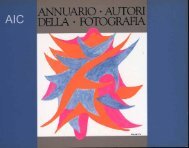AIC, 1988 - AIC Associazione Italiana Autori della Fotografia ...
AIC, 1988 - AIC Associazione Italiana Autori della Fotografia ...
AIC, 1988 - AIC Associazione Italiana Autori della Fotografia ...
You also want an ePaper? Increase the reach of your titles
YUMPU automatically turns print PDFs into web optimized ePapers that Google loves.
<strong>AIC</strong><br />
"One from the heart" di Vittorio Storaro<br />
colour within a scene "One from the<br />
Heart", 1982, F. Coppola) — without<br />
counting all the different types of<br />
lighting, i.e. direct or diffused lighting,<br />
backlighting.<br />
b) Set Design: in which the laws of<br />
perspective and sign language place the<br />
actor in relation to everything that has<br />
been constructed around him<br />
("Profession Reporter", 1984, M.<br />
Antonioni).<br />
c) Sound: which means dialogue, noise<br />
and music and the different way in<br />
which they are used. 1 can still "hear",<br />
like a distant echo in my mind,<br />
"Strategia del Ragno", 1970, B.<br />
Bertolucci.<br />
a) Acting: acting in the cinema doesn't<br />
just mean learning dialogue, but all<br />
the actions which create it. Enclosed in<br />
a rectangular space, and obliged to<br />
enter or exit from either left or right,<br />
the actor's movements are confined<br />
within limits and executed in relation<br />
to precise camera movements. Not only<br />
this, his actual body, divided up into<br />
close-ups, full-shots and two.shots,<br />
literally multiplies, without his being<br />
aware, all the possible meanings that<br />
can be communicated ("Casablanca",<br />
1943, M. Curtis, is a fine example of<br />
all of this).<br />
However, if photography (light), set<br />
design (space), sound (words, noise,<br />
music), and acting (behaviour) are<br />
essential languages of the cinema,<br />
there are also others which exist, or<br />
can be obtained by a process of<br />
deduction. Any one of the above can<br />
be added to or subtracted from the<br />
other, can divide or multiply. Certain<br />
cinema favours photography and set<br />
design, other acting, and so on...<br />
However, all these languages exist<br />
because there is a camera which moves.<br />
It moves equipped with specific lenses<br />
that have been chosen. An entire story<br />
is lived out between the different focal<br />
lengths. And then there is that<br />
fantastic way of filling a space, with a<br />
camera movement. If my head were a<br />
new Mitchell 35 m/m, and my range<br />
of vision extended beyond 120°, I<br />
could, by merely turning my head,<br />
effect the most incredible pan-shots<br />
(vertical, horizontal, any which way);<br />
then, tired of remaining stationary, I<br />
could get up and track in on my actor,<br />
and around him; but then, if I<br />
happened to become angry and decided<br />
to take off, I could effect a dolly, and<br />
play at escaping from, or homing in on,<br />
the "reality" 1 was filming.<br />
This way, I would be "declining" the<br />
various languages indispensible to<br />
cinema, bringing out certain qualities<br />
at times, then others, and in the truly<br />
great moments, all of them. Then, the<br />
film really would be cinema!<br />
Next, we come to the problem —<br />
certainly not minor — of meaning.<br />
Adopting all these different languages<br />
and then "conjugating" them, it is<br />
inevitable that they will be interpreted<br />
in a particular way — even if the<br />
possible interpretations are less than<br />
one would imagine. The literal,<br />
figurative, metaphorical and<br />
metonymic meanings, and the complex<br />
question of editing, immediately<br />
become understandable if a<br />
combinatorial analysis of the "writing"<br />
is effected beforehand. One always<br />
writes a story by starting at the end.<br />
Knowing the end at the beginning,<br />
permits the precise distribution and<br />
construction of the significants and<br />
significance. The advantage of this<br />
narrative method is that there is far<br />
less possibility of meaning getting lost<br />
— although it might become hidden at<br />
another point — as it is confined, and<br />
has obliged the "text" to effect a<br />
return journey before starting out.<br />
The various points of view from- which<br />
a film can be interpreted<br />
(psychological, sociological, economical,<br />
structural, linguistic etc...) become<br />
material for as many analyses again;<br />
one has to remember, however, that<br />
meaning is always subjective, cannot<br />
really be tested, and is certainly<br />
deceptive.<br />
It is knowledge that permits us to<br />
understand, but we have to adopt a<br />
pragmatic approach if we are not to<br />
fall into the trap of emotional<br />
judgement. The characters, imprisoned<br />
their roles (whether they be jealous, in<br />
love, unfaithful, or whatever) throw<br />
down the gauntlet at the story,<br />
without ever being able to vanquish it.<br />
They will be brutally betrayed by the<br />
"writing", which will run them through<br />
the heart with its customary precision.<br />
In a film, we see all the things that<br />
happen in life, both to the characters,<br />
and ourselves. In other words, the<br />
cinema recounts all life's various<br />
conflicts by transforming them into<br />
"reality"; while reality itself having<br />
too much time to communicate,<br />
remains a sham.<br />
Music is created by all the instruments<br />
in an orchestra, each existing in<br />
relation to the other, and a film is<br />
created in the same way. It is therefore<br />
a mistake, merely critically speaking,<br />
to concentrate solely on the story while<br />
watching a film, instead of trying to<br />
define the different languages which<br />
tum it into cinema.<br />
The former distinction between cinema<br />
and film returns to assert and avenge<br />
itself, continuing, in the silence, to be<br />
valid.









